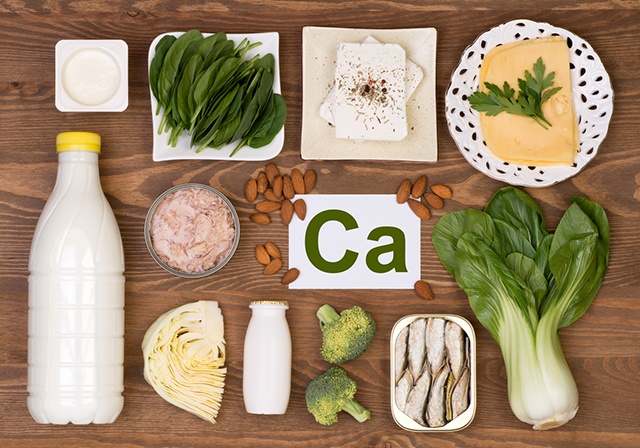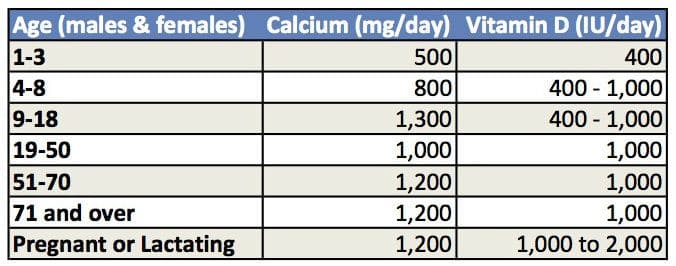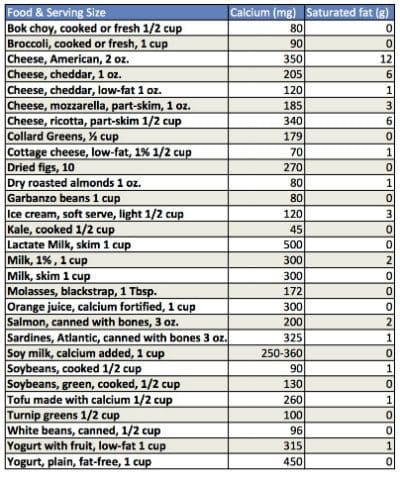
Calcium and Vitamin D Facts
Calcium is a mineral used for building and maintaining strong bones and teeth. It is also essential for proper functioning of your heart, brain and nerves. Calcium is not made in the body — it must be absorbed from the foods we eat. If your diet is low in calcium, your body will steal away calcium from your bones to maintain normal blood calcium levels. Over time, this leads to weaker bones and eventually osteoporosis — a disorder in which your bones become more fragile and increases your risks of future fractures.
Up until the age of 21 for males and 26 for females, your bones can store calcium. After that, your bones are as strong as they are going to get and, without medication, are not able to store calcium. So it important that you maintain a daily calcium intake in order that your bones will not be depleted of its calcium.
Vitamin D is important for the absorption of calcium and aids in improving muscle strength and balance.
New research shows that Vitamin D protects against osteoporosis, some types of cancer and autoimmune diseases such a Parkinsonism, multiple sclerosis and diabetes. It is estimated that 10% of the American population is Vitamin D deficient. (In Chicago, where the yearly average number of sunny days is 84, this percentage is even higher.) Recent studies have shown that 40% of patients, who visit an orthopaedist’s office, are Vitamin D deficient.
Now your bones only will store the calcium you consume up until the age of 21 for males and 26 for females. At that point in your life, your bones are as strong as they are going to get. After that, it is
Remember, though, your body will only absorb up to 1500 mg of calcium per day. So if you try to “overload” on calcium to “make up for some loss time”, you will only have high calcium levels in your stools and urine and you will put yourself at an increased risk of having kidney stones.
It is also important to get your daily calcium in your diet rather than in pills. A recent study of cardiac patients found those who took 1000 mg tablets of calcium per day had less fractures (good) but more heart attacks and strokes (very bad). It is believed that in pill form, the calcium is rapidly absorbed. The calcium blood level spikes and the calcium then will stick to plaques in blood vessels, increasing the chance of heart attacks and strokes. Calcium in food form is much more slowly absorbed and thereby decreasing the chance of sticking to plaque.
The importance of Vitamin D is often overlooked. New research shows great promise for Vitamin D in protecting against osteoporosis, some types of cancer, heart disease and various autoimmune diseases such a Parkinsonism, multiple sclerosis and diabetes. Vitamin D also aids in improving muscle strength and balance.
When the sun’s UV-B rays hit the skin, a reaction takes place that enables skin cells to manufacture vitamin D. If you’re fair skinned, experts say going outside for 10 minutes in the midday sun—in shorts and a tank top with no sunscreen—will give you enough radiation to produce about 10,000 international units of the vitamin.
It is estimated that 10% of the American population is Vitamin D deficient. (In Chicago, where there is an average of 84 sunny days per year, I am sure this percentage is even higher.) Recent studies have shown that 40% of patients who visit an orthopaedist’s office are Vitamin D deficient. In my office, 70% of patients with fracture are Vitamin D insufficient or deficient.
The government’s dietary recommendations are 200 IUs a day up to age 50, 400 IUs to age 70, and 600 IUs over 70. But many experts believe that these recommendations are far too low to maintain healthful vitamin D levels. They advocate for supplementation in the winter of about 2,000 IUs per day and a dose of daily sunshine in the summer and, if you live in Chicago, 1000IU per day.
Calcium and Vitamin D Needs by Age:
Here are some important tips for bone health:
- Take a daily multivitamin to give yourself a start on calcium and vitamin D, but be aware that you need to do more.
- Read food labels and choose foods and beverages that are high in calcium and Vitamin D.
- Avoid soda pop. The phosphates in soda will bind to the calcium and deplete your calcium.
- Try calcium fortified foods (foods that do not normally contain calcium but have had calcium added). Examples include fortified orange juice and ready-to-eat cereals.
- Cook calcium-containing foods in a minimal amount of water and for the shortest time possible to retain calcium.
- Do some weight-bearing activities such as weight training, walking, running or dancing on a daily basis.
- Avoid smoking and excessive alcohol intake.
- Get 15 minutes of sunlight at least three times per week. However, in Chicago during the months of May through June, the sun is not high enough in the sky for you to produce the necessary amount of vitamin D. Taking supplements during that time is essential.
- If you decide to take a calcium supplement, choose calcium citrate for better absorption and be certain it contains Vitamin D.
- Take no more than 500 mg calcium at one time. Too much calcium in pill form is absorbed too fast, resulting in transient high blood serum levels. This can lead to kidney stones and/or hardening of your arteries, increasing your risk of heart attacks and/or strokes. Since calcium is not absorbed as quickly from foods, it is recommended that you obtain at least 50% of your daily calcium intake from your diet.
Suggestions for adding calcium to your diet:
- If you eat dairy, consume 3 servings of low-fat or fat-free milk every day.
- Cook cereals with skim milk or calcium-fortified non-dairy beverages (instead of water) or add 2 tablespoons non-fat dry milk.
- Eat 8-oz of low-fat or fat-free yogurt each day.
- Make smoothies with frozen fruit, fortified orange juice and low-fat or fat-free yogurt.
- Add low-fat cheeses to sandwiches, salads and pizzas.
- Add sardines to salads or sandwiches.
- Use low-fat cheese on bread or toast instead of butter or margarine.
- Start your day with a high calcium food such as orange juice.
- Include higher calcium greens such as spinach or collards to round out your meal.
- Know how much calcium is in your food:

Good reading references:
